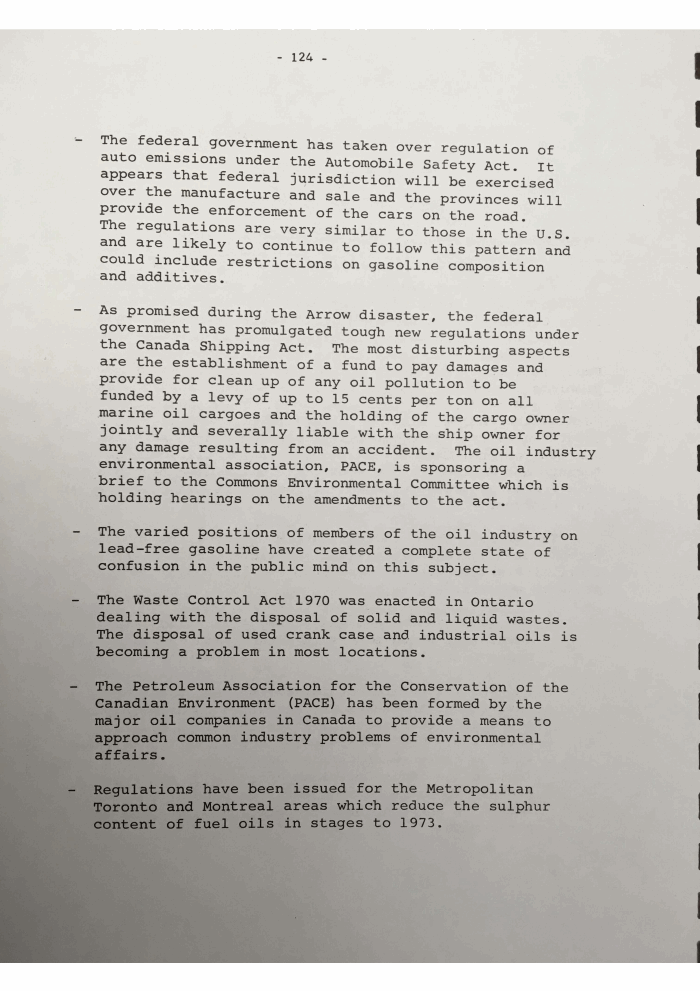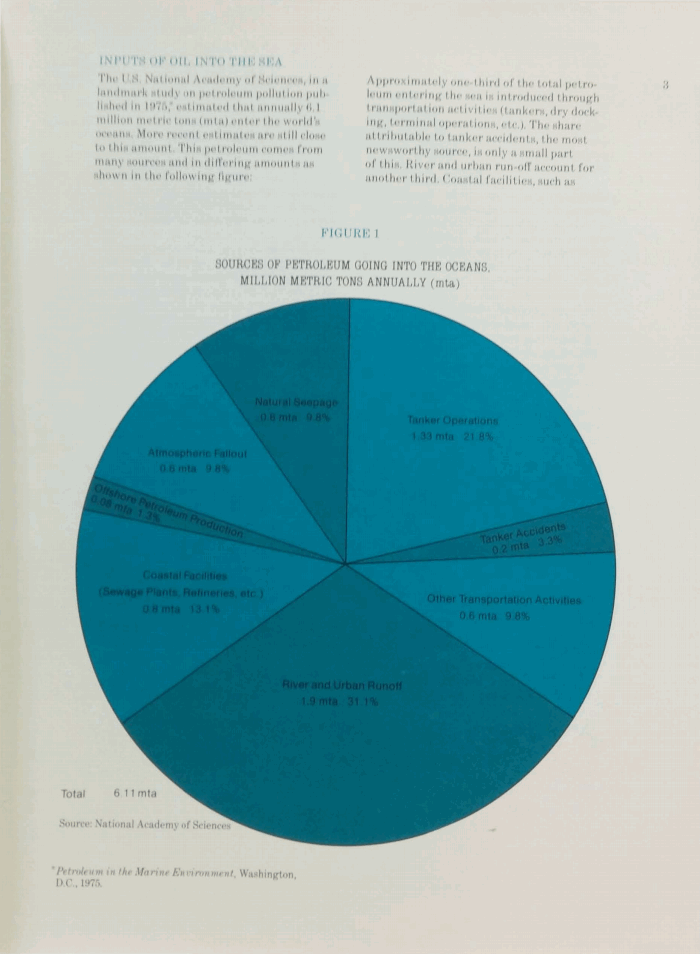On February 4, 1970, the oil tanker SS Arrow was carrying a cargo of heavy bunker oil for Imperial Oil Limited when it encountered rough weather off the east coast of Canada. The ship’s captain had not sailed this route before and reportedly had no navigational charts. The ship itself had known problems with its navigation system. When the radar warned the crew of trouble ahead, the warning was ignored. The ship promptly ran aground on a well-known hazard, Cerberus Rock, ultimately spilling approximately 2.5 million gallons of oil, which coated 190 miles of shoreline.
Nearly two decades before the Exxon Valdez catastrophe in Alaska, the Arrow oil spill became a public relations black eye for Imperial Oil, a Canadian subsidiary of Exxon, and internal company documents published today by DeSmog and the Climate Investigations Center reveal that the company viewed the environmental disaster more in the context of improving its public image than improving safety measures that would reduce these types of environmental risks.
A 1971 Imperial document titled “Research Requirements” notes that in response to the Arrow spill the Canadian “federal government has promulgated tough new regulations … the most disturbing aspects are the establishment of a fund to pay damages and provide for clean up of any oil pollution to be funded by a levy of up to 15 cents per ton on all marine oil cargoes and the holding of the cargo owner jointly and severally liable with the ship owner for any damage resulting from an accident.”
In addition to lamenting the fact that regulations would require companies be accountable for oil spills, the document mentions the industry response to the Arrow disaster and new regulations: forming a new oil industry public relations group, the Petroleum Association for the Conservation of the Canadian Environment (PACE).
One of the actions prompted by one of the first major oil spills in North American waters was the Canadian oil industry launching a group to influence public opinion and legislation.
Spill Cleanup Technology ‘Primitive at Best’
The 1971 research document highlights Imperial’s concerns about the cost of cleaning up oil spills but also repeatedly notes how oil spill response at the time was largely ineffective.
Once again Imperial’s motivation to improve oil spill clean-up technology was driven by its desire to reduce costs and avoid regulation. The issue of clean-up costs comes up repeatedly in this 1971 internal document:
The document also highlights Imperial’s efforts to explore for oil in the Arctic. It notes the lack of information on how to clean up oil spills in the Arctic environment, identifying this as a problem which could result in opposition to drilling for Arctic oil. In addition, the company discusses beginning Arctic oil spill research “as most important, particularly from a Public Relations standpoint.”
In 1971 Imperial, which is majority-owned by Exxon, appeared concerned about oil spills — not due to the risks they posed to the environment but instead due to the risks they posted to the Canadian oil giant’s ability to continue drilling and transporting oil. That’s despite Imperial admitting that the technology to deal with oil spills at that time was deficient.
Managing Public Relations a High Priority
Within this 1971 research requirements document, Imperial was transparent about the industry’s inability to adequately clean up oil spills and noted that finding ways to lower the costs of cleanup was a priority. However, the document gives a clear impression that the main focus of Imperial’s cleanup effort was the corporate brand.
While the nearly 200 page document makes repeated mention of the company’s public image and public opinion, Imperial’s overall approach is perhaps summarized best in four words appearing on the page titled, “Anti-pollution measures in ice-infested waters.”
On that page the company notes that the ability to minimize the effects of oil pollution in ice-infested waters has “significance to the company” because it would “safeguard its public image.”
Throughout the document, the focus is always on the public image, rather than Arctic waters or the life supported by them.
‘Natural and Self-correcting’
A 1979 document also published from the Imperial Oil collection comes from the parent company Exxon and is addressed to Imperial executives. It’s a pamphlet that shows, nine years after the Arrow oil spill, the company was using language to downplay the environmental impacts of oil spills in the ocean. The title of the pamphlet — which was prepared by Exxon’s Public Affairs Department — is “Fate and Effects of Oil In the Sea.”
The memo makes claims which minimize human spills of oil, which are typically a sudden influx of large volumes into the ocean, and frame them as comparable to the slow ooze of natural oil seeps which some marine life has adapted to degrading: “Just as nature and man contribute to the appearance of petroleum in the sea, so do they contribute to its removal.” It also frames the issue as just another eventuality: “The presence of oil in the marine environment is to some extent unavoidable.”
This document essentially argues that while oil tanker spills are problematic, they’re just a literal drop in the ocean. It points to the reality that oil tankers and the shipping industry in general would dump oil directly in the ocean all the time, making oil spills a rounding error in the big picture.
A figure in the 1979 document shows oil tanker accidents represented 200,000 metric tons, or 3.3 percent of annual petroleum going “into the oceans” each year, drawn from a total which included seeps where oil reserves near the surface naturally release oil into marine waters.
The document goes into detail about natural processes that can lead to oil in the ocean and the way they can break down that oil.
“Just as nature and man contribute to the appearance of petroleum in the sea, so do they contribute to its removal. Natural processes, both chemical and biological, degrade the petroleum hydrocarbons. Man, in a more limited fashion, tries to contain and clean up oil spilled into the sea when his efforts at prevention have failed.”
In the conclusion, after highlighting the ways that oil naturally degrades in the environment, the Exxon pamphlet says that, when it comes to the issue of oil in the sea, “to some extent the problem is both natural and self-correcting.”
Fate and the Exxon Valdez
Nineteen years after Imperial dealt with the Arrow oil spill in Canada, the grounding of the Exxon Valdez oil tanker released 11 million gallons of oil into Alaska’s Prince William Sound. Much like the Arrow disaster, the Exxon Valdez spill was attributed in part to the fact that the radar system on the ship was not functioning properly and reportedly hadn’t been for a year. And just as Imperial had documented 19 years earlier, the industry had no effective means to deal with the spill. The cleanup was also expensive, with Exxon claiming it spent $4.3 billion to remove the oil, which polluted a thousand miles of coastline.
Additionally, the spill resulted in another undesired outcome for these major oil companies, as it is generally credited with spurring the U.S. Congress to pass the Oil Pollution Act of 1990. This was the first major legislation in the U.S. designed to address oil spill prevention and response.
One result of the Exxon Valdez spill, and the Oil Pollution Act and international maritime agreements that followed, was that the oil industry was forced to adopt double-hulled oil tankers as a protection against spilling oil cargo after groundings and collisions. The widespread adopotion of double-hulled tankers and improved navigational systems (or at least functioning navigational systems) have reduced oil tanker spills since the early 1990s.
But oil in the ocean remains a public relations issue for Imperial even in recent years. In 2015 — 45 years after the grounding of the SS Arrow — the ship, still sunk off the coast of Nova Scotia, began leaking oil again. Apparently, leaving a wrecked tanker with more than 5,000 gallons of oil at the bottom of the ocean was not a “natural and self-correcting” problem.
DeSmog has reached out to Imperial Oil for comment.
Check out the rest of DeSmog’s series: Imperial Oil Files: How a Canadian Oil Giant Followed Exxon into Climate Denial and view the entire document archive
Main image: Crop of image of Esso holding tanks attached to an Imperial Oil refinery. Credit: TheKurgan, CC BY–SA 3.0
Subscribe to our newsletter
Stay up to date with DeSmog news and alerts










